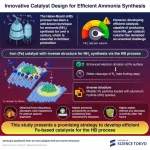(Press-News.org) Ghent, 24 January 2025 – Our livers contain many different types of immune cells. New research by the team of Prof. Charlotte Scott (VIB-UGent Center for Inflammation Research) and colleagues now reveals that a specific activation state of one of these cell types is required for tissue repair following injury. This suggests these cells may be useful as new therapeutic targets for various liver conditions. The work appears in the journal Immunity.
Liver immune cells
Macrophages are specialized immune cells located in every tissue of the body, where they play crucial roles in maintaining tissue homeostasis, responding to injury, and facilitating tissue repair. In the healthy liver, most macrophages are classified as Kupffer cells (KCs). However, upon liver injury, as seen, for example, in obesity, another subset of macrophages called lipid-associated macrophages (LAMs) is recruited.
The specific functions of these cells in the context of liver injury were however unclear. Do KCs adapt upon injury to help heal the liver or is this a function for LAMs?
New work by the team of Prof. Charlotte Scott (VIB-UGent) and colleagues has addressed this specific question demonstrating that the LAM phenotype is critical for liver repair. Moreover, this research revealed that the KCs are not static post-injury, as previously thought and instead adapt to the new microenvironment also taking on a LAM-like phenotype, allowing them to also participate in the repair.
Heterogeneity and plasticity
“We used several advanced research methods, such as single-cell RNA sequencing and spatial transcriptomics, to investigate the heterogeneity, locations, and functions of hepatic macrophages in multiple injury settings,” says Dr. Ania Bujko, from the Scott lab and co-first author of the study, “this allowed us to identify similar populations of LAMs and LAM-like KCs irrespective of the injury type, which were found specifically at the site of injury. This finding was exciting as it suggests these cells may be useful therapeutic targets across various liver diseases.”
However, before the usefulness of these cells as a therapy could be considered, their functional contribution to injury and repair had to be assessed.
“To determine what these populations do in repair, we made use of different animal models to selectively delete genes of interest from the LAMs, LAM-like KCs, or both cells in the various liver injury contexts,” says Federico De Ponti, PhD student in the Scott lab and co-first author of the study. “This revealed that expression of the Trem2 gene is essential in at least one of these populations (LAMs or LAM-like KCs) for the efficient clearance of dying and injured liver cells”.
In other words, loss of TREM2 from both populations prevented repair, whereas repair could occur when expression was maintained in at least one of the populations. So, TREM2 in liver macrophages is critical for promoting tissue repair and preventing excessive fibrosis, suggesting its potential as a therapeutic target.
In addition, the study also demonstrates that the LAM identity is induced in the different macrophage populations through their uptake and clearance of dying cells at the site of injury.
“As this study highlights LAM-like macrophages as a potential therapeutic target to improve liver repair,” says Prof. Scott, “the information that clearance of dying cells drives this activation state could be utilized to generate such cells for therapeutic purposes, bringing us one step closer. While there are still a few questions remaining regarding these cells, that we are now investigating, this study demonstrates that the complex dynamics of hepatic macrophages and their functional roles in liver injury and repair could have significant implications for a variety of liver conditions.”
END
Specific types of liver immune cells are required to deal with injury
2025-01-24
ELSE PRESS RELEASES FROM THIS DATE:
How human activity has shaped Brazil Nut forests’ past and future
2025-01-24
The significant decline in genetic diversity in the Amazon Basin, following historical events such as European colonisation, deforestation and the extinction of megafauna such as the sloth – the main seed dispersal agents, is of particular concern for the genetic health of Brazil Nut trees (Bertholletia excelsa). As one of the most impacted keystone species in rainforests, Brazil Nut trees are essential for biodiversity and a vital income source for local economies.
A crucial study led by researchers from the Max Planck Institute of Geoanthropology and the Max Planck Institute for Biology Tübingen ...
Doctors test a new way to help people quit fentanyl
2025-01-24
During the COVID-19 pandemic, when fentanyl overdoses surged, doctors were desperate to find ways of helping their patients.
They knew that buprenorphine could help people stop using opioids, but it was much harder to start the treatment for those who used fentanyl, which lasts longer in the body. Taking buprenorphine while fentanyl is still active can push someone abruptly into withdrawal.
So, they started giving patients small doses of the drug over a series of days to slowly build up the drug in their systems until their bodies could handle a higher dose of buprenorphine.
Now, ...
Long read sequencing reveals more genetic information while cutting time and cost of rare disease diagnoses
2025-01-24
One in every 10 people worldwide is impacted by a rare genetic disease but about 50% of them remain undiagnosed despite rapid increases in genetic technology and testing. Even when a person does have access to testing, the process of getting a diagnosis can take about five years or more, which is sometimes too late for patients, who are often children, to start the right treatment.
This is partly because current clinical testing uses a method called short-read sequencing, which cannot access information in certain regions of the genome and so may miss ...
AAAS and ASU launch mission-driven collaborative to strengthen scientific enterprise
2025-01-24
Today, the American Association for the Advancement of Science and Arizona State University announced a five-year partnership, the AAAS + ASU Collaborative. Together, the institutions will elevate and amplify strategies and practices that advance scientific excellence and enable a boldly inclusive scientific enterprise serving society.
In its first phase, the Collaborative includes a joint prize, an invitation for the ASU STEMM community to join AAAS as Elemental Members, and events in Washington, D.C., addressing policy-relevant science topics.
“Focusing science and scientific advances on the challenges we face is essential to the advancement ...
Medicaid-insured heart transplant patients face higher risk of post-transplant complications
2025-01-24
A new study led by UCLA Health highlights the link between socioeconomic disadvantage, Medicaid insurance, and poorer survival rates after heart transplantation. Researchers found that Medicaid-insured heart transplant patients had a higher likelihood of developing cardiac allograft vasculopathy (CAV), a condition that affects transplanted hearts and can limit long-term survival. It has been reported that CAV contributes to more than 30% of all deaths in the first 5 to 10 years following heart transplantation.
The study, which included heart transplant recipients aged 18 and older, divided ...
Revolutionizing ammonia synthesis: New iron-based catalyst surpasses century-old benchmark
2025-01-24
NH3 is one of the most important chemicals in today’s world, as it is used in the production of fertilizers to boost agricultural yields and sustain the ever-growing global population. For over 100 years, NH3 production has relied on the Haber–Bosch (HB) process, which combines nitrogen (N2) and hydrogen in the presence of a catalyst. Interestingly, an iron-based catalyst developed a century ago (called ‘Promoted-Fe’) still remains at the forefront of mass NH3 production, despite countless efforts to find more energy-efficient alternatives. In the HB process, where NH3 is produced by a catalyst-filled reactor with a limited volume, ...
A groundbreaking approach: Researchers at The University of Texas at San Antonio chart the future of neuromorphic computing
2025-01-24
A review article about the future of neuromorphic computing by a team of 23 researchers, including two authors from UTSA, was published today in Nature. Dhireesha Kudithipudi, the Robert F. McDermott Endowed Chair in Engineering and founding director of MATRIX: The UTSA AI Consortium for Human Well-Being, served as the lead author, while Tej Pandit, a UTSA doctoral candidate in computer engineering, is one of the co-authors. The review article, titled “Neuromorphic Computing at Scale,” examines the state of neuromorphic technology and presents a strategy for building large-scale neuromorphic systems.
The research is part of a broader effort ...
Long COVID, Italian scientists discovered the molecular ‘fingerprint’ of the condition in children's blood
2025-01-24
One day Long Covid in children could be objectively diagnosed with a blood test, thanks to the help of Artificial Intelligence (AI). In fact, a study by the Università Cattolica del Sacro Cuore, Rome campus - Fondazione Policlinico Universitario Agostino Gemelli IRCCS and the Ospedale Pediatrico Bambino Gesù IRCCS, has highlighted the molecular signature of Long Covid in plasma in paediatric age and used an AI tool capable of making the diagnosis based on the results of the blood sample, with 93% ...
Battery-powered electric vehicles now match petrol and diesel counterparts for longevity
2025-01-24
Battery-powered electric vehicles are now more reliable and can match the lifespans of traditional cars and vans with petrol and diesel engines - marking a pivotal moment in the drive towards sustainable transportation, a new study reveals.
Researchers used nearly 300 million UK Ministry of Transport (MOT) test records charting the ‘health’ of every vehicle on the United Kingdom’s roads between 2005 and 2022 to estimate vehicle longevity and provide a comprehensive analysis of survival rates for different powertrains.
The international research ...
MIT method enables protein labeling of tens of millions of densely packed cells in organ-scale tissues
2025-01-24
A new technology developed at MIT enables scientists to label proteins across millions of individual cells in fully intact 3D tissues with unprecedented speed, uniformity, and versatility. Using the technology, the team was able to richly label whole rodent brains and other large tissue samples in a single day. In their new study in Nature Biotechnology, they also demonstrate that the ability to label proteins with antibodies at the single-cell level across whole brains can reveal insights left hidden by other widely used labeling methods.
Profiling the proteins that cells are making is a staple of studies in biology, neuroscience and related fields because the ...




